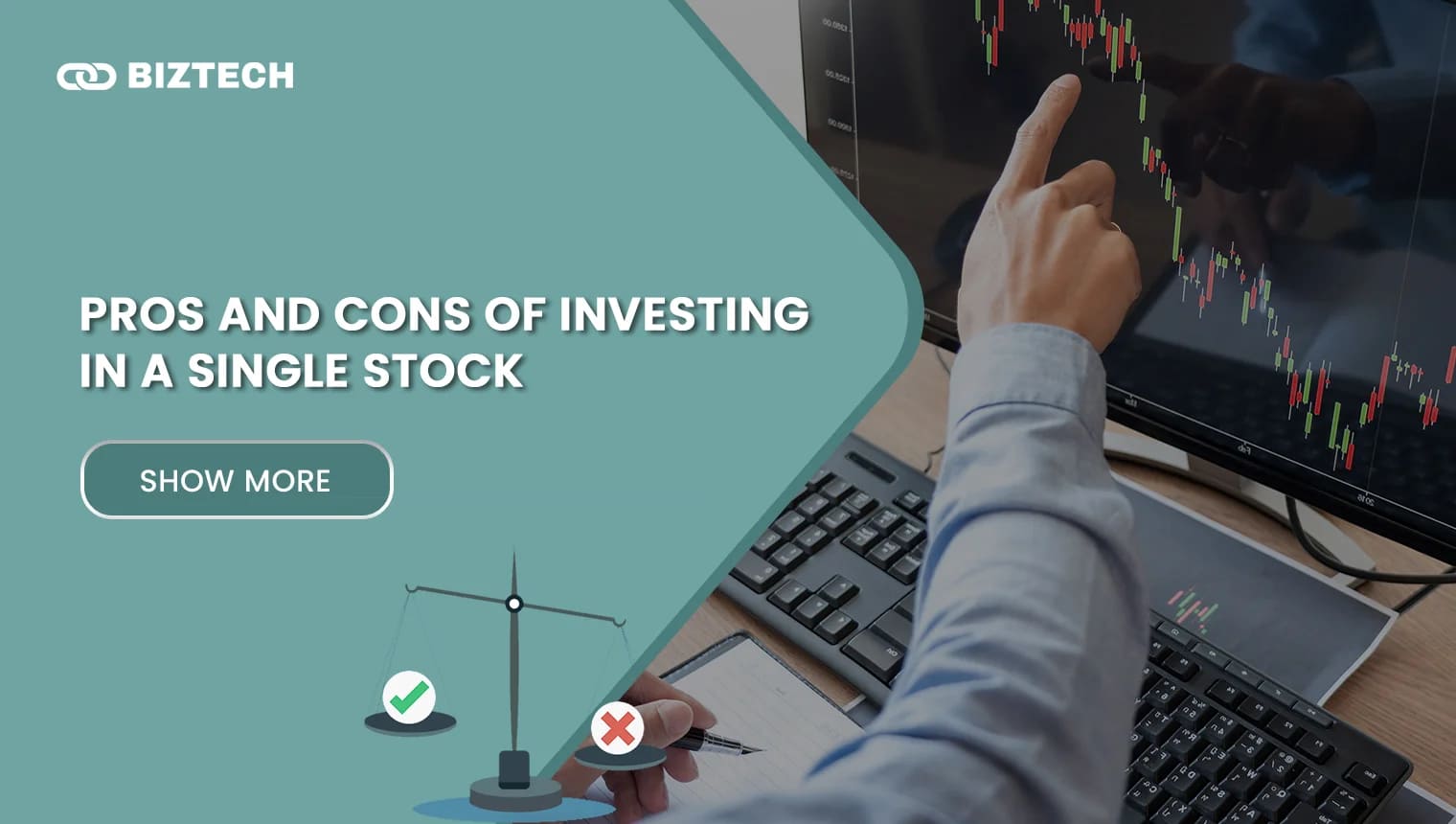Have you ever envisioned yourself selecting the next major success story in the stock market? Placing your investment in single stocks enables you to concentrate your resources on a company you have faith in, possibly yielding substantial returns if it prospers.
- Pros of Investing in Single Stocks
- 1. Potential for Exceptional Returns
- 2. No Management Fees
- 3. In-Depth Analysis and Control
- 4. Voting Rights (Where Applicable)
- Cons of Investing in a Single Stock
- 1. High Risk Due to Lack of Diversification
- 2. Time Commitment: Active Management
- 3. Emotional Investing
- Choosing Whether to Invest in a Single Stock
- Understanding Taxes on Single Stock Investments
- Conclusion
However, is entrusting all your assets to one entity the optimal choice?
Conversely, diversification distributes your investment among various companies, presenting a potentially more stable journey with reduced risk. Thus, which approach suits you best?
This article will walk you through the advantages and drawbacks of investing in individual stocks investment, leaving you to decide which investment method works for you and your financial goals.
[su_box title=”Key Takeaways” box_color=”#000877″ title_color=”#ffffff” radius=”6″]
- High Risk, High Reward: Single stocks offer the potential for much greater returns than bonds, but they also come with significantly increased risk.
- Fee Savings: By investing directly in a company, you can bypass the ongoing management fees associated with mutual funds and ETFs.
- In-Depth Understanding, Enhanced Confidence: Delve into the company you believe in, bolstering your confidence in your investment decisions.
- Shareholder Influence (For Applicable Stocks): Ownership of shares in certain companies grants voting rights on specific matters.
- Prioritize Diversification: While incorporating single stocks into your strategy can be beneficial, prioritize diversifying your investments across various companies and asset classes to build a more secure portfolio.
[/su_box]
Pros of Investing in Single Stocks
1. Potential for Exceptional Returns
While diversification aims for steady growth, concentrating on individual stocks presents the enticing prospect of much higher returns.
Picture a company poised for a breakthrough in technology or a new market. Investing early in such a company and witnessing its stock price soar can result in gains far exceeding those of a diversified portfolio comprised of more established, slower-growing companies.
For instance, suppose you invest $1,000 in Company X, a fledgling tech startup with groundbreaking products. Over five years, Company X experiences explosive growth, causing its stock price to surge by 1000%.
Your initial $1,000 investment would then balloon to an impressive $10,000, surpassing the returns of many bonds or even some diversified portfolios.
2. No Management Fees
Mutual funds and ETFs offer diversification and convenience but come with a cost.
These funds typically levy annual management fees, ranging from a fraction of a percent to over 1% of your total investment, which can erode your long-term returns.
By opting for a single stock, you circumvent these ongoing management fees, retaining more of your potential profits.
For instance, imagine investing $10,000 in a mutual fund with a 1% annual management fee. Over a decade, this 1% fee would accumulate to $1,000 deducted from your potential return.
By selecting a single stock, you sidestep these continuous deductions, allowing for the possibility of maximizing the growth of your investment.
3. In-Depth Analysis and Control
Diversification offers exposure to numerous companies but might lack a deep understanding of any single company.
Investing in single stocks offer the opportunity for comprehensive research into the company’s business model, competitive landscape, and future growth potential.
This deeper knowledge enables more informed investment decisions, instilling confidence in your supporting company.
4. Voting Rights (Where Applicable)
Ownership of shares in certain publicly traded companies grants voting rights on specific matters, such as electing board members or approving major acquisitions.
While the influence of an individual vote may seem minor, for impassioned investors, having a say in the direction of a company they deeply believe in can be a valuable perk.
Cons of Investing in a Single Stock
While the allure of substantial rewards with a single stock is enticing, it’s imperative to grasp the notable risks involved:
1. High Risk Due to Lack of Diversification
Investing in a single stock mirrors placing all your eggs in one basket, disregarding a fundamental investing principle: diversification.
Diversification spreads investments across various companies and asset classes, aiming to mitigate losses from underperforming assets with gains from others.
Vulnerability to Single Stock:
A single company confronts a plethora of risks that can significantly impact its stock price, including:
- Management Missteps: Leadership errors, product failures, or unexpected legal challenges can precipitate a sharp decline in a company’s stock.
- Industry Downturns: Even well-managed companies can suffer amid industry downturns. For instance, a company heavily reliant on a specific technology may see its stock price plummet if that technology becomes obsolete.
- Economic Fluctuations: Broader economic shifts like recessions or interest rate changes can adversely affect all companies, but a single stock lacks the cushion of diversification against these risks.
For instance, suppose you invest all your capital in Company Y, a prominent manufacturer of a particular type of smartphone.
If a competitor introduces a superior product, Company Y’s sales could nosedive, resulting in significant losses for your investment.
2. Time Commitment: Active Management
Contrary to a hands-off approach with a diversified portfolio, investing in individual stocks demands active management, involving:
- Company Research: Conducting thorough research into a company’s financial status, competitive landscape, future outlook, and management team before investing.
- Market Monitoring: Remaining abreast of industry developments, news events, and factors influencing the company’s stock price.
- Portfolio Rebalancing: Adjusting holdings as market conditions evolve to maintain the desired risk level and diversification. This may entail selling well-performing stocks or acquiring more of those experiencing price declines.
3. Emotional Investing
The stock market can induce emotional turbulence. Witnessing fluctuations in investment value can trigger emotions like fear and greed.
Fear might prompt premature selling of a stock at a loss, while greed could lead to prolonged holding of a declining stock, fueled by hopes of a rebound.
Choosing Whether to Invest in a Single Stock
The choice to invest in single stock risk relies on a meticulous evaluation of your risk tolerance and investment objectives. Here is a breakdown to guide you through this pivotal decision:
1. Understanding Risk Tolerance:
- Are you risk-averse, prioritizing stable growth? If so, a single stock might pose too much risk for you. Diversifying across various companies and asset classes offers a safer approach.
- Are you comfortable with potentially heightened volatility in pursuit of higher returns? If you possess a lengthy investment horizon and can endure market fluctuations, then a single stock might warrant consideration, but only within a well-diversified portfolio.
2. Aligning with Your Investment Goals:
- Short-term goals: Single stocks generally are not suited for short-term objectives (less than 5 years) due to their inherent volatility. Quick selling could result in substantial losses.
- Long-term goals (e.g., retirement): With a lengthy investment horizon (10+ years), you might weather market swings associated with a single stock. However, diversification remains vital to mitigate risk.
Factors to Assess When Selecting a Single Stock:
Suppose you have concluded that a single stock aligns with your risk tolerance and long-term aspirations. Here are key factors to scrutinize before diving in:
- Company Financials: Delve into the company’s financial statements, examining metrics like revenue growth, profitability (earnings), debt levels, and cash flow. A robust financial foundation is pivotal for sustained growth.
- Industry Outlook: Investigate the industry landscape in which the company operates. Is it a burgeoning sector with favorable trends? Are there disruptive technologies or impending regulatory shifts that could influence the industry?
- Competitive Landscape: Identify the company’s primary competitors. Does it possess a durable competitive edge, or is it easily replaceable?
- Management Team: The caliber of the leadership team profoundly impacts a company’s trajectory. Research the CEO and other key executives’ experience and track record.
[su_note note_color=”#ffffff” text_color=”#000000″ radius=”10″]
Remember:
Despite thorough research, investing in single stocks entails substantial risk. This approach should comprise only a small portion of your overall portfolio, with diversification remaining the cornerstone of your long-term investment strategy.
[/su_note]
Understanding Taxes on Single Stock Investments
Taxes are an inevitable part of stock ownership in the USA. Familiarizing yourself with these implications can help you make informed investment decisions.
Here’s a breakdown of the key tax considerations:
-
Capital Gains Taxes: When you sell a stock for more than you paid for it (including any commissions), you realize a capital gain. These gains are taxed at different rates depending on how long you held the stock before selling (holding period):
- Short-term Capital Gains (less than one year): Taxed at your ordinary income tax rate, which can be as high as 37% in 2024.
- Long-term Capital Gains (more than one year): Generally taxed at lower rates than ordinary income. The specific rate depends on your taxable income:
- 0% for taxpayers in the lowest tax brackets.
- 15% for most other taxpayers.
- 20% for higher-income earners.
-
Dividends: Companies may distribute a portion of their profits to shareholders in the form of dividends. These payments are typically taxed as ordinary income in the year they are received.
Remember: This is a simplified overview. For specific tax advice, consult with a tax professional. They can help you determine your potential tax liability based on your unique circumstances.
Related Post: Taxable Brokerage Accounts: What You Need to Know
Conclusion
Investing in single stocks offers the potential for amplified returns, but comes with magnified risks. Carefully evaluate your risk tolerance and investment goals. For risk-averse or short-term investors, diversification remains crucial. However, long-term investors comfortable with market fluctuations can leverage single stocks for potential growth.
Remember, thorough research is paramount. Utilize the wealth of resources available in the USA, including financial websites, news outlets, and online brokerages. Ultimately, the decision is yours. Consider the information provided to make informed choices aligned with your financial objectives and risk tolerance.
Disclaimer: The information provided herein is for informational purposes only and does not constitute financial advice, recommendation, or endorsement. Individual financial situations vary, and any investment decisions should be made based on individual circumstances, consultation with a qualified financial advisor, and thorough consideration of risks and potential returns. Past performance of investments is not indicative of future results. Any opinions expressed are subject to change without notice and may not reflect the views of all contributors or entities involved. No representation or warranty, express or implied, is made regarding the accuracy, completeness, or reliability of the information provided. Users of this information do so at their own risk and are encouraged to conduct their own research and due diligence before making any financial decisions.






